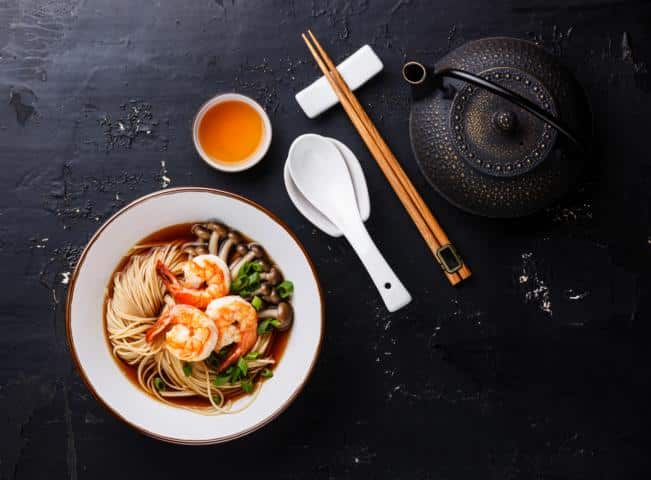There is something to the saying “other countries – other customs” when it comes to eating ramen soups.
There are a few things to keep in mind. Not only observing the absolute no-go’s and rituals , but also slurping soup with chopsticks instead of a spoon is definitely a challenge for people from non-Asian cultures.
Although no one expects you to follow proper Japanese etiquette, especially if you are eating ramen soup at home. However, if you are in a restaurant, if you follow the Ramen Knigge, you are guaranteed to see a smile on the staff’s faces when you thank them in Japanese for the food.
Like any European, Japanese are happy when their traditions are respected and followed.


When you enter a ramen restaurant in Japan, it is customary to remove your shoes beforehand and slip into the slippers provided. Of course, this is not necessary in the small cookshops and street restaurants. You can tell the need by the shoes standing outside the location and the slippers waiting for you.
Greet the host, whether the host or the private host, with a small bow. In Japan, people don’t shake hands.
In many ramen restaurants, including small street-side soup kitchens, you will now be handed a refreshment towel . Use it to clean your hands, and only your hands. On hot days in Asia, it may be tempting to use the cold, damp cloth to cool the face and neck as well. However, this is an absolute no-go.

A traditionally made Japanese ramen soup consists of the broth, various garnishes and the ramen noodles. The yellowish color of the noodles, comes from the potassium carbonate and sodium carbonate contained in the kansui. The flavor of the soup is created by the broth. Whereby miso (fermented soybeans), shio (salt), shoyu (soy sauce) and tonkutso (boiled pork bones) are the best known variants.
Ramen noodles content
Various Broths


In Japan, it is said that biting the
Ramen noodles
brings bad luck.
That is why in Japan people slurp the soup passionately. However, there is another reason for this: slurping allows the hot noodles to cool down a bit.
In Japan, the noodles are eaten as quickly as possible because the noodles taste best when warm. Ramen thus always arrive steaming hot on the table.
This also explains why Japanese people always seem to eat at top speed. Everyone focuses exclusively on the food. There is a time to eat here and then a time to talk. In some Japanese restaurants, it is usually not customary to talk either.
If you’re in Tokyo at one of the many ramen restaurants, for the most part all you can hear is the slurping of the other patrons. The noise level is completely different from the one we are used to in the Western world.
Slurping, on the other hand, is part of the good tone here. You don’t have to be embarrassed when the ramen noodles disappear into your mouth with a proper smacking sound.
What is the same, however, also here often the food is photographed beforehand and shared on social networks. Asians are absolute leaders in this area.
The ramen is eaten with chopsticks .
Only the soup is consumed with a spoon.
You can Broth but you can also slurp it directly from the bowl. This is quite common in Japan and no one will look at you funny in a Japanese restaurant. To do this, take the bowl in both hands and bring it to your mouth.
In a Japanese restaurant, you can observe that many Japanese always leave a lot of broth. This does not mean that this one did not taste good. However, the soup only serves to flavor the ramen and the main actors are the noodles and side dishes. Just the
Tonkotsu soup
is often left over because it is very fatty.
Even if it is difficult, you should patiently eat with the chopsticks. If it doesn’t work out at all, just ask for a fork at a restaurant.


When you are finished eating, you should always put the
Chopsticks
always put the chopsticks back where you got them.
If you have received noble chopsticks, they were guaranteed to be brought on a small plate. Now put them back here. In no case should you place the sticks at an angle in the bowl. As mentioned earlier, this would be a symbol of death for the Japanese.
Placing the sticks across the bowl is an option that is also possible.
If they are disposable chopsticks, they are packed back into the wrapper.
Thanking the Japanese staff for the delicious food and bringing a smile to the staff’s face.

Subscribe to the newsletter
Once a quarter the “Ramennews
In the newsletter we present new dishes.
Contact
Ramen-suppe.de is a participant in the Amazon Associates Program, an affiliate advertising program designed to provide a means for sites to earn advertising fees by advertising and linking to Amazon.com. Ramen Soup will share in the sales with a commission.
© 2019-2021 Ramen Soup - All rights reserved